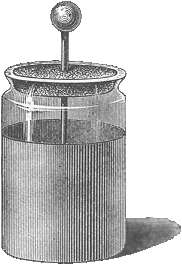Leiden bottle
The Leiden bottle , also known as Kleist bottle , condensation bottle or bottle capacitor is an early historical design of an electrical capacitor . The structure consists of a glass vessel, for example a bottle, to which metal coverings, for example two metal foils, are attached on the inside and outside. The glass represents the insulator between the two metal coverings, the two metal coverings are the electrodes of a capacitor.
By the construction and the materials used, such as glass or ceramic with high dielectric strength Leyden jars have high normally withstand voltage , which extends into the region of the high voltage goes. Since the available volume of the bottle is only insufficiently utilized, the electrical capacitance is only small compared to the capacitor designs that are common today, such as ceramic capacitors or film capacitors .
Leyden bottles have been replaced by optimized designs and are no longer of any major importance. Due to their simplicity in construction, they are used as a didactic demonstration object in the field of training, as well as for replicas of historical electrical devices.
history
The principle of the Leiden bottle was invented independently on October 11, 1745 by the cathedral dean Ewald Georg von Kleist in Cammin ( Pomerania ) and in 1746 by the physicist Pieter van Musschenbroek in the city of Leiden , when they were carrying out laboratory tests with corresponding arrangements of glasses and metal parts received electric shock .
Various documents also mention Andreas Cunaeus (1712–1788) as a co-inventor and friend of Musschenbroek; others incorrectly equate Musschenbroek with the name Cunaeus in brackets.
construction
During experiments, Kleist had stuck a nail into a water-filled bottle and connected it to an electrifying machine. When the nail was pulled out later, he received a powerful electric shock . Musschenbroek had a similar experience. Different scholars repeated the experiment and varied the arrangement. Johann Heinrich Winckler moved the conductor from the middle to the inside wall of the bottle, surrounded it with a metal jacket and experimented with different liquids such as water, melted butter and wine. The Leiden bottle was given its final shape in 1748 by the two London doctors William Watson and John Bevis . They both renounced the liquid and covered the bottle walls inside and outside with tin foil, the so-called tinfoil . The Danzig physicist Daniel Gralath the Elder combined several Leyden bottles into one battery for the first time and was thus able to increase the effect by connecting them in parallel .
First uses
The popular in the 18th and early 19th century public demonstrations of electricity also was Kleist shock or vibration impact presented, in which a human chain was dealt a blow from a Leyden jar, which fell subjects in convulsions. Georg Christoph Lichtenberg wrote in a physics textbook:
“In Paris, a few years ago, it was believed to have been found that the thrust always ended at 'frigidis et impotentibus'. The Count of Artois, who heard about it, summoned the castrats of the opera; and the observation was found to be wrong. In this way the electrifying machine has lost the honor of being a useful instrument in the assembly halls of consistories and marriage courts. "
These attempts also remained popular after the Nuremberg mathematics teacher Johann Gabriel Doppelmayr died in 1750 from being hit by a Leiden bottle.
Physical
A Leyden bottle represents a design of an electrical capacitor. In the form of a bottle, this design corresponds to a good approximation of a cylinder capacitor , the calculation of the electrical capacitance is therefore the same as for a cylinder capacitor . Alternatively, the specific capacity value of a Leyden bottle can be measured with an AC voltage bridge.
The electrical capacitance of typical Leyden bottles, which are based on the historical structure, is the size of a commercially available glass bottle and with electrolytically applied copper coatings approx. 10 nF to 100 nF.
Hazard warning
Due to their structure, Leiden bottles only have a very low equivalent series resistance (ESR) and can briefly emit high current pulses in the event of a short circuit in the charged state. If Leiden bottles are charged to high voltage, touching the two metal electrodes at the same time can lead to an electrical accident .
When disassembling a Leiden bottle into its individual parts, it must be ensured that the charge remains partially stored in the glass body. This effect depends, among other things, on the insulating material. After reassembly, the charge reappears on the electrodes and can lead to an electric shock. Likewise, a Leiden bottle can be charged again some time after it has been discharged as a result of dielectric absorption .
Larger or parallel-connected Leiden bottles should therefore be handled in the same way as power capacitors according to their safety rules : short-circuit after use or discharge via a discharge resistor and short-circuit the two electrodes during storage or transport in order to avoid unwanted charging due to dielectric absorption.
Individual evidence
- ↑ Excerpt from the Kleists' family biography with a link to the original copy of the letter to Krüger
- ↑ Andreas Cunaeu . Families from the Netherlands.
- ↑ Walter Conrad (Ed.): History of Technology in Schlaglichtern , 1997, Meyers Lexikonverlag, p. 58.
- ↑ Contribution of the University of Ulm on the development history of capacitors, accessed on October 19, 2018.



